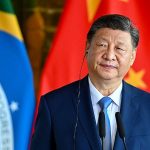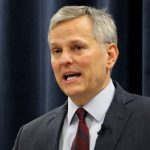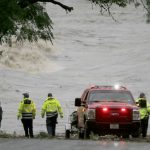Trump said he was dispatching the military across Washington, D.C., and urged governors nationwide to “dominate” their streets with National Guard deployments. If they refused, he said, he would send troops to American cities.
“Mayors and governors must establish an overwhelming law enforcement presence until the violence has been quelled,” he said. “If a city or state refuses to take the actions that are necessary to defend the life and property of their residents, then I will deploy the U.S. military and quickly solve the problem for them.”
It was not immediately clear under what authority Trump could deploy U.S. troops to patrol states without governors requesting them. A senior Defense Department official said Trump had not enacted the Insurrection Act, which gives the president the power to deploy active military troops on U.S. soil. It was last used in 1992 to respond to riots following the acquittal of police officers accused of beating Rodney King.
Trump also said he was dispatching “thousands and thousands of heavily armed soldiers, military personnel and law enforcement officers to stop the rioting, looting, vandalism, assaults and the wanton destruction of property” in the nation’s capital.
The comments offered a stunning split screen to the strife that has engulfed the nation following the death of George Floyd. While Trump spoke in the Rose Garden, hundreds of people were gathered just outside Lafayette Park across the street from the White House to protest for a fourth consecutive night.
Several loud bangs echoed just before Trump took the podium as law enforcement fired tear gas into a crowd of peaceful protesters. Moments earlier, Attorney General William Barr was spotted reviewing the law enforcement setup at the park.
A citywide curfew instituted by D.C.’s Democratic mayor was set to go into effect at 7 p.m., and National Guard troops had assembled in the nation’s capital to back up law enforcement. New York City and other metropolitan areas had imposed similar curfews in an attempt to contain the unruly protests.
Trump said the D.C. curfew would be “strictly enforced.”
Floyd, an unarmed black man, was killed in Minneapolis police custody one week ago after a white officer knelt on his neck. Video captured by onlookers spread across the internet, provoking massive outrage throughout the United States.
The president’s Rose Garden speech came after debate over whether he should deliver a formal address in light of the turmoil that has engulfed the nation.
But his prepared remarks only briefly touched on Floyd’s death — and did not cover the unrest over police brutality leading up to the protests. Instead, they committed to Trump’s insistence that “law and order” win out over unruly demonstrators.
“Americans were rightly sickened and revolted by the brutal death of George Floyd. My administration is fully committed that for George’s family justice will be served. He will not have died in vain,” Trump said. “But we cannot allow the righteous cries of peaceful protesters to be drowned out by an angry mob.”
He cited several examples in his speech of aggression toward law enforcement in recent days and vandalism of local businesses. He did not mention any instances of police advancing on protesters or injuries or deaths among activists.
Trump mentioned a fire set at the historic St. John’s Church close to the White House, calling that and other developments acts of “domestic terror.”
“I will fight to protect you. I am your president of law and order and an ally of all peaceful protesters,” he said. “But in recent days, our nation has been gripped by professional anarchists, violent mobs, arsonists, looters, criminals, rioters, antifa and others.”
“I want the organizers of this terror to be on notice that you will face severe criminal penalties and lengthy sentences in jail,” he continued.
Upon concluding his remarks, Trump walked to St. John’s Church to view the boarded-up building alongside a host of administration officials. He held up a Bible, posed for a photo and told reporters he would keep the country “nice and safe” before returning to the White House.
The remnants of tear gas fired a short time earlier to clear protesters still lingered in the air, with journalists on the scene reporting coughing as they observed the president’s visit.
Trump earlier Monday told governors on a conference call that they need to “dominate” the streets with National Guard troops and accused them of being “weak” in their initial handling of the demonstrations. His rhetoric prompted criticism from some Democratic governors who warned he was inflaming tensions and making the situation worse.
Illinois Gov. J.B. Pritzker (D), who told Trump on the call that he was “extraordinarily concerned” by his rhetoric, said on CNN following the Rose Garden address that Trump was unwilling to listen to those who wanted him to bring the temperature down.
“I think he just wants to create a tone in which it’s law and order versus people standing up for their rights, and he’d just as soon run over people’s rights,” Pritzker said.
The president’s Rose Garden remarks were his first on-camera comments since Saturday evening when he addressed Floyd’s death and subsequent protests at the beginning of remarks in Cape Canaveral, Fla., following a historic SpaceX launch. Trump called Floyd’s killing a “grave tragedy” while rebuking protesters causing destruction, blaming the violent demonstrations on antifa and “radical left-wing groups.”
Demonstrations around the country have grown increasingly tense in the last 48 hours, with police firing tear gas and rubber bullets into crowds and some protesters resorting to looting and vandalism.
Trump commented on the protests late last week and throughout the weekend as they developed in Minneapolis, where Floyd was killed, and spread across the country. The president has earned criticism for some of his rhetoric, with some Republicans characterizing the tweets as unhelpful.
Trump tweeted early Friday that protesters in Minneapolis were “thugs” and warned that “when the looting starts, the shooting starts” — repeating a phrase used by a white Miami police chief in the civil rights era regarding the aggressive policing of black neighborhoods. Trump insisted last week he was unaware of the origins of the phrase.
After protests broke out around the White House over the weekend, Trump warned that demonstrators would face “vicious dogs” and “ominous weapons” if they came too close to the complex.
Story cited here.
























